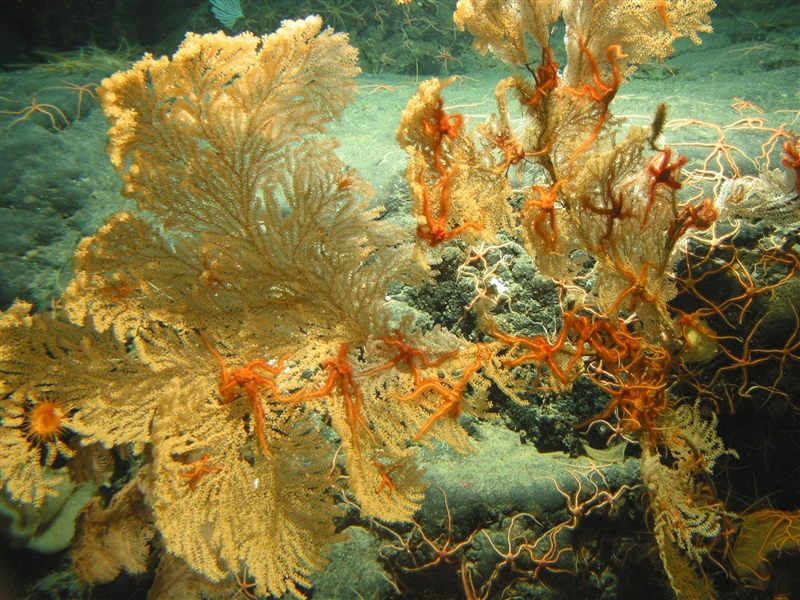A new research effort focuses on Alaska’s sub-Arctic corals and sponges
NOAA's four-year Alaska Deep-Sea Coral and Sponge Initiative will search some of the nearly three-quarters of Alaska waters have yet to be surveyed by sonar.

There is a hotbed of colorful corals in an ocean region that might seem unlikely — the cold waters of the southern Bering Sea and Aleutian Islands.
Now that area, along with the Gulf of Alaska, is getting special attention for its corals and sponges. The National Oceanic and Atmospheric Administration scientists have launched a four-year program to better understand the coral and sponge communities lying at on the Alaska seafloor.
The Alaska Deep-Sea Coral and Sponge Initiative is part of NOAA Fisheries’ Service national Deep-Sea Coral Research and Technology Program. The program has a rotating schedule that puts researchers into different marine regions in what are typically three- or four-year cycles. Alaska’s turn in the rotation started in 2020.
It is a mission of discovery, especially considering that nearly three-quarters of Alaska waters remain unsurveyed by sonar, NOAA officials say.
“We don’t know where deep-sea corals are, especially in Alaska,” said Heather Coleman, coordinator of the Deep-Sea Coral Research and Technology Program. “We’re largely in the stage of finding these corals and sponges.”
Within Alaska, the Aleutian Islands have some of the densest and most diverse coral habitats in the world, with representatives of all taxa and stands of red tree corals “taller than anyone else thought,” many rising over six feet, Coleman said.
The research into corals and sponges goes beyond discovery; there is follow-up work needed to classify whatever corals and sponges are found, especially in the dense communities in the central and western Aleutians.
“We’re trying to understand the diversity, and there’s much more diversity in Alaska,” said Jerry Hoff of the Alaska Fisheries Science Center, the lead scientist for the Alaska effort.
As of now, there have been about 150 species of corals and more than 200 species of sponges identified in Alaska waters in habitats ranging from shallow areas to depths ranging to more than 6,000 meters underwater, according to NOAA Fisheries’ Alaska Fisheries Science Center.
Corals and sponges are key to habitat that supports fish — and the nation’s biggest commercial fish harvests. They provide protections and nursery areas for fish, and their importance to fish may go beyond shelter. One NOAA Fisheries project is tracking fat content in rockfish to see if fish health and reproductive success is linked to coral and sponge habitats.
There are other potential benefits to the sponges. One green, golf ball-sized species called Latrunculia austini shows promise as a source of medicine to treat cancer, for example.
While Alaska’s deep-sea corals are plentiful and diverse, its sponges are even more so, according to the experts.
Scientists have already identified 52 species of sponges in the Gulf of Alaska and over 125 in the Aleutian Islands, and new sponge discoveries are announced periodically. That includes the discovery in the western Aleutians of a genus of sponge never seen before in the world and difficult to classify, according to a 2020 study.
Globally, corals and sponges are suffering from climate change and acidification. For these stationary and slow-growing life forms, changes in water conditions are perilous. Warmer temperatures cause coral bleaching, for example, and acidification robs the marine environment of the calcium that is needed for growth.
The current coral and sponge program is evaluating those threats in Alaska, but there is a more immediate problem, Coleman said. “Right now, we’re focused on the more pressing threat of sea-floor trawling,” she said.
The North Pacific Fishery Management Council, which manages fisheries in federal waters of Alaska, several years ago established some no-trawling zones in the Aleutians to protect coral habitat. More may be warranted. One objective of the Alaska coral and sponge survey is to develop a risk assessment that considers both direct impacts from human activities like fishing and changing ocean conditions. Another task is to map untrawlable areas. Methods in the project range from direct underwater examinations and photography to genetic analysis of samples to modeling that will extrapolate patterns into hard-to-reach areas.
The COVID-19 pandemic limited some of the work and extended the timeframe for the Alaska surveys. Work in 2020 was limited to planning, and though some fieldwork could be conducted this year, it focused only on the Gulf of Alaska, Hoff said. Next year, fieldwork is expected to be more expansive, moving to the eastern Bering Sea and the Aleutians, he said.
Expansion north beyond the Bering Strait is not on the schedule, despite a recommendation produced out of the previous round of Alaska coral and sponge surveys.
The 2017 report describing the findings from the 2012-14 field seasons noted that Arctic regions of Alaska “are largely unsurveyed,” though they could hold corals and sponges that have been documented in Canada.
“Basic research to map the distribution and abundance of corals and sponges in Alaska’s Arctic is recommended,” that report said.
Those farther-north surveys might happen in the future, Hoff said. “There’s always interest as the Arctic opens up for various reasons,” he said.


